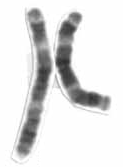3q29 microdeletion syndrome
3q29 microdeletion syndrome is a rare genetic disorder resulting from the deletion of a segment of chromosome 3. This syndrome was first described in 2005.[1][2]
| 3q29 microdeletion syndrome | |
|---|---|
| Other names | 3qter deletion, Monosomy 3q29 |
 | |
| Chromosome 3 is associated with this condition | |
Presentation
The clinical phenotype of 3q29 microdeletion syndrome is variable. Clinical features can include mild/moderate intellectual disability with mildly dysmorphic facial features (long and narrow face, short philtrum and a high nasal bridge). Of the 6 reported patients, additional features including autism, ataxia, chest-wall deformity and long, tapering fingers were found in at least two patients.[1] A review of 14 children with interstitial deletions of 3q29, found 11 who had the common recurrent 1.6Mb deletion and displayed mental retardation and microcephaly.[3]
The variability of phenotype is underscored by the report on a 6 and 9/12 year-old male patient with a de novo chromosome 3q29 microdeletion identified by BAC array comparative genomic hybridization assay (aCGH), with accompanying normal 46,XY high-resolution chromosome analysis. The patient has language-based learning disabilities and behavioral features consistent with diagnoses of autism and attention deficit hyperactivity disorder (ADHD) of the inattentive type. He also displays some other features previously associated with chromosome 3q29 microdeletion such as an elongated face, long fingers, and joint laxity. Most notably the patient, per formal IQ testing, was not found to have frank intellectual disability as has been previously reported among patients with chromosome 3q29 terminal deletion, but rather the patient has demonstrated an average full-scale IQ result. This report further expands the phenotypic spectrum to include the possibility of normal intelligence as corroborated by formal, longitudinal psycho-educational testing.[4]
The presence of two homologous low copy repeats either side of the deletion break-point suggests that non-allelic homologous recombination is the likely mechanism underlying this syndrome.
Genetics
The microdeletion, around 1.6 million base pairs, in length and encompasses 5 known genes and 17 uncharacterised transcripts. These include transferrin receptor, choline-phosphate cytidylyltransferase A, RNF168, serine/threonine-protein kinase, nuclear cap-binding protein complex, melanotransferrin, DLG1 and D-beta-hydroxybutyrate dehydrogenase
Research
Research on the risk for developing schizophrenia in Ashkenazi Jews and other populations showed that 3q29 microdeletion syndrome leads to a significant higher rate of schizophrenia.[5] In addition, a deletion at 3q29 was found to confer a striking increase to the odds of developing schizophrenia in a study of copy number variants and their effect on that disease.[6]
References
- Willatt L, Cox J, Barber J, et al. (July 2005). "3q29 Microdeletion Syndrome: Clinical and Molecular Characterization of a New Syndrome". Am. J. Hum. Genet. 77 (1): 154–60. doi:10.1086/431653. PMC 1226188. PMID 15918153.
- Koochek M (2006). "Clinical and molecular characterization of a new syndrome: the case of 3q29 microdeletion syndrome". Clin. Genet. 69 (2): 121–3. doi:10.1111/j.1399-0004.2006.00570c.x. Archived from the original on 2013-01-05.
- Ballif BC, Theisen A, Coppinger J, Gowans GC, Hersh JH, Madan-Khetarpal S, Schmidt KR, Tervo R, Escobar LF, Friedrich CA, McDonald M, Campbell L, Ming JE, Zackai EH, Bejjani BA, Shaffer LG (2008). "Expanding the clinical phenotype of the 3q29 microdeletion syndrome and characterization of the reciprocal microduplication". Mol Cytogenet. 1: 8. doi:10.1186/1755-8166-1-8. PMC 2408925. PMID 18471269.
- William Cobb, Arne Anderson, Clesson Turner, Ruth D. Hoffman, Steven Schonberg, Sondra W. Levin, 1.3 Mb de novo deletion in chromosome band 3q29 associated with normal intelligence in a child, European Journal of Medical Genetics, Volume 53, Issue 6, November–December 2010, Pages 415-418, ISSN 1769-7212, 10.1016/j.ejmg.2010.08.009.
- Jennifer Gladys Mulle et al.; "Microdeletions of 3q29 Confer High Risk for Schizophrenia". The American Journal of Human Genetics, August 5, 2010 doi:10.1016/j.ajhg.2010.07.013
- Rees, E., et al. (2014). Analysis of copy number variations at 15 schizophrenia-associated loci. British Journal of Psychiatry, 204(02), 108–114. doi:10.1192/bjp.bp.113.131052
External links
| Classification |
|
|---|---|
| External resources |
|
- DECIPHER database entry for 3q29 microdeletion syndrome